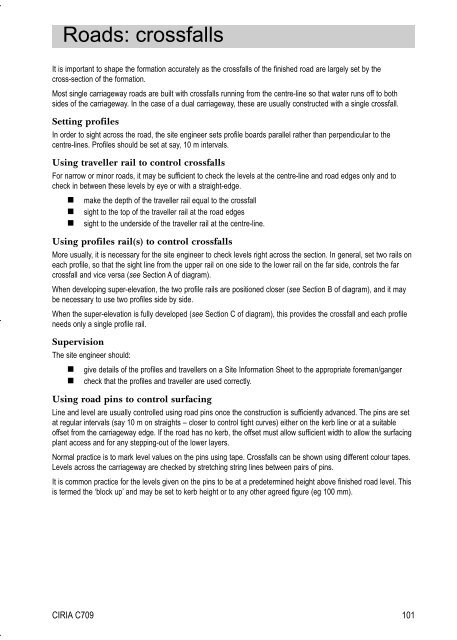Download - Engineering Surveyor
Download - Engineering Surveyor
Download - Engineering Surveyor
- No tags were found...
Create successful ePaper yourself
Turn your PDF publications into a flip-book with our unique Google optimized e-Paper software.
Roads: crossfallsIt is important to shape the formation accurately as the crossfalls of the finished road are largely set by thecross-section of the formation.Most single carriageway roads are built with crossfalls running from the centre-line so that water runs off to bothsides of the carriageway. In the case of a dual carriageway, these are usually constructed with a single crossfall.Setting profilesIn order to sight across the road, the site engineer sets profile boards parallel rather than perpendicular to thecentre-lines. Profiles should be set at say, 10 m intervals.Using traveller rail to control crossfallsFor narrow or minor roads, it may be sufficient to check the levels at the centre-line and road edges only and tocheck in between these levels by eye or with a straight-edge. make the depth of the traveller rail equal to the crossfall sight to the top of the traveller rail at the road edges sight to the underside of the traveller rail at the centre-line.Using profiles rail(s) to control crossfallsMore usually, it is necessary for the site engineer to check levels right across the section. In general, set two rails oneach profile, so that the sight line from the upper rail on one side to the lower rail on the far side, controls the farcrossfall and vice versa (see Section A of diagram).When developing super-elevation, the two profile rails are positioned closer (see Section B of diagram), and it maybe necessary to use two profiles side by side.When the super-elevation is fully developed (see Section C of diagram), this provides the crossfall and each profileneeds only a single profile rail.SupervisionThe site engineer should: give details of the profiles and travellers on a Site Information Sheet to the appropriate foreman/ganger check that the profiles and traveller are used correctly.Using road pins to control surfacingLine and level are usually controlled using road pins once the construction is sufficiently advanced. The pins are setat regular intervals (say 10 m on straights – closer to control tight curves) either on the kerb line or at a suitableoffset from the carriageway edge. If the road has no kerb, the offset must allow sufficient width to allow the surfacingplant access and for any stepping-out of the lower layers.Normal practice is to mark level values on the pins using tape. Crossfalls can be shown using different colour tapes.Levels across the carriageway are checked by stretching string lines between pairs of pins.It is common practice for the levels given on the pins to be at a predetermined height above finished road level. Thisis termed the ‘block up’ and may be set to kerb height or to any other agreed figure (eg 100 mm).CIRIA C709101
















